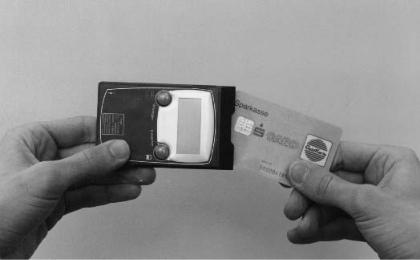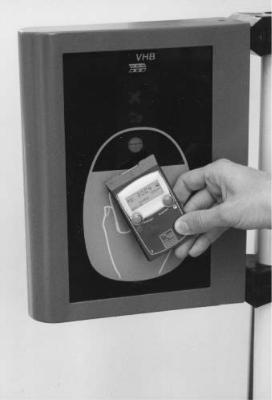
Finkenzeller K.RFID handbook.2003
.pdf
344 |
13 EXAMPLE APPLICATIONS |
while passengers board, plus the additional security risk presented by the continuous distraction of the driver.
•Paper tickets are thrown away after use, although the manufacture of fraud-proof tickets for transport companies is becoming more and more expensive.
•In German cities in particular, losses of up to 25% must be taken into account due to fare-dodgers (Czako, 1997). This is because German transport companies have very liberal travelling conditions and permit entry to the underground system and buses without travel passes first being checked.
•Association discounts can only be calculated on the basis of costly random counts, which leads to imprecision in the calculation.
13.2.2 Requirements
Electronic fare management systems have to fulfil very high expectations and requirements, particularly with regard to resistance to degradation and wear, write and read speed and ease of use. These expectations can only be satisfactorily fulfilled by RFID systems. The most common format for contactless smart cards is the ID-1 format and, recently, wrist watches.
13.2.2.1Transaction time
The time taken for the purchase or verification of a travel pass is particularly critical in transport systems in which the pass can only be checked inside the vehicle. This is a particular problem in buses and trams. In the underground railway, passes can be checked at a turnstile, or by conductors. A comparison of different methods shows the clear superiority of RFID systems in terms of transaction times (Table 13.1).
13.2.2.2Resistance to degradation, lifetime, convenience
Contactless smart cards are designed for a lifetime of 10 years. Rain, cold, dirt and dust are a problem for neither the smart card nor the reader.
Table 13.1 Passenger processing times for different technologies. Source: transport companies in Helsinki, taken from Czako (1997)
Technology |
Passenger processing time |
|
(s) |
|
|
RFID I (remote coupling) |
1.7 |
Visual verification by driver |
2.0 |
RFID II (close coupling) |
2.5 |
Smart card with contacts |
3.5 |
Cash |
>6 |
|
|
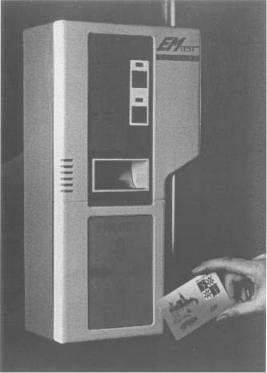
13.2 PUBLIC TRANSPORT |
345 |
Figure 13.3 Contactless reader in a public transport system (photo: Frydek-Mistek project, Czechoslovakia, source: reproduced by permission of EM Test)
Contactless smart cards can be kept in a briefcase or handbag and are therefore extremely convenient to use (Figure 13.3). Transponders can also be fitted into wristwatches.
13.2.3 Benefits of RFID systems
The replacement of conventional paper tickets by a modern electronic fare management system based on contactless smart cards provides a multitude of benefits to all those involved. Although the purchase costs of a contactless smart card system are still higher than those of a conventional system, the investment should repay itself within a short period. The superiority of contactless systems is demonstrated by the following benefits for users and operators of public transport companies.
Benefits for passengers
•Cash is no longer necessary, contactless smart cards can be loaded with large amounts of money, passengers no longer need to carry the correct change.
•Prepaid contactless smart cards remain valid even if fares are changed.
•The passenger no longer needs to know the precise fare; the system automatically deducts the correct fare from the card.

13.2 PUBLIC TRANSPORT |
347 |
|
Table 13.2 Different fare systems for payment with contactless smart card |
|
|
|
|
|
Fare system 1 |
Payment takes place at the beginning of the journey. A fixed amount is |
|
|
deducted from the contactless smart card, regardless of the distance |
|
|
travelled. |
|
Fare system 2 |
At the beginning of the journey the entry point (check-in) is recorded on the |
|
|
contactless card. Upon disembarking at the final station (check-out), the |
|
|
fare for the distance travelled is automatically calculated and deducted |
|
|
from the card. In addition, the card can be checked at each change-over |
|
|
point for the existence of a valid ‘check-in’ entry. To foil attempts at |
|
|
manipulation, the lack of a ‘check-out’ record can be penalised by the |
|
|
deduction of the maximum fare at the beginning of the next journey. |
|
Fare system 3 |
This model is best suited for interlinked networks, in which the same route |
|
|
can be travelled using different transport systems at different fares. Every |
|
|
time the passenger changes vehicles a predetermined amount is deducted |
|
|
from the card, bonus fares for long distance travellers and people who |
|
|
change several times can be automatically taken into account (see |
|
|
Figure 13.4). |
|
Best price |
In this system all journeys made are recorded on the contactless card for a |
|
calculation |
month. If a certain number of journeys was exceeded on one day or in |
|
|
the month as a whole, then the contactless card can automatically be |
|
converted into a cheaper 24 hour or monthly card. This gives the customer maximum flexibility and the best possible fares. Best price calculation improves customer relations and makes a big contribution to customer satisfaction.
centres in Asia (Seoul, Hong Kong, Singapore, Shanghai), and European cities (Paris, London, Berlin).
In 1994 and 1995 around 1 million contactless smart cards were produced per year worldwide for public transport applications. In the period 1996 to 1997 the volume rose to over 40 million cards per year (Droschl, 1997). The expected volume for 1998 alone is around 100 million contactless smart cards worldwide for public transport applications (Hamann, 1997). Given annual growth rates of 60% or more, we can expect the annual demand for contactless smart cards to have risen to 250 million by the turn of the century.
The highest growth rates for contactless smart cards in public transport applications will be in the Asiatic-Pacific area, because of the new infrastructures being created here using the latest technologies (Droschl, 1997).
13.2.6 Example projects
13.2.6.1Korea – Seoul
The largest electronic travel pass system (AFC) yet to use contactless cards was commissioned at the start of 1996 in the metropolis of Seoul, South Korea (see Figures 13.5–13.7). The Korean ‘Bus Card’ is a prepaid card, issued with a basic value of 20 000 W− ( 17 euro). Fares are calculated according to fare system 1. A bus journey costs an average of 400 W− ( 0.35 euro), but every time the passenger changes vehicles they must pay again.
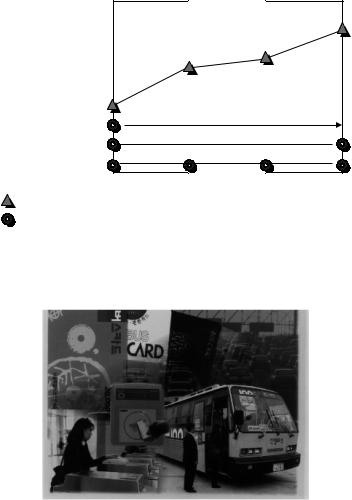
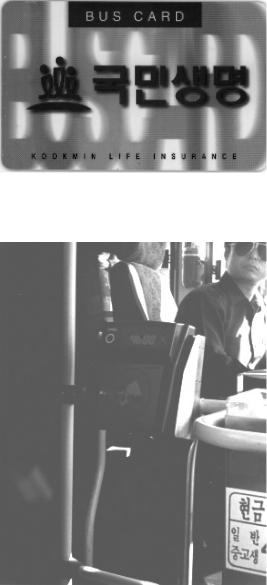
13.2 PUBLIC TRANSPORT |
349 |
Figure 13.6 Contactless smart card for paying for journeys in a scheduled bus in Seoul (reproduced by permission of Klaus Finkenzeller, Munich)
Figure 13.7 Reader for contactless smart cards at the entrance of a scheduled bus in Seoul (reproduced by permission of Klaus Finkenzeller, Munich)
13.2.6.2Germany – Luneburg,¨ Oldenburg
One of the first smart card projects in Germany’s public transport system is the Fahrsmart project in the KVG Luneburg¨ — VWG Oldenburg transport association. The subsidised Fahrsmart pilot project was launched by the Ministry for Education and Research in this area as early as 1990/91. Around 20 000 smart cards with contacts
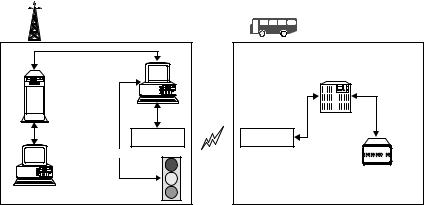
350 |
13 EXAMPLE APPLICATIONS |
were issued to customers for this project. However, significant flaws in the installed systems became evident during this pilot project; the biggest problem was that the registration time of over three seconds per passenger was considered to be excessive.
At the beginning of 1996 a new field test was launched, the Fahrsmart II system based upon contactless smart cards. The RFID technology used was the MIFARE system by Philips/Mikron. System integration, i.e. the commissioning of the entire system, was performed by Siemens VT (Berlin).
The Fahrsmart system automatically calculates the cheapest price for the customer (best price guarantee). The passenger must check in at the start of the journey using their personal smart card and check out at the end of the journey. The journey data obtained are collected in the on-board computer and stored on the smart card for verification.
When the vehicle returns to the depot at the end of the day the current day’s data is sent from the vehicle computer to the station server via an infrared interface (Figure 13.8). The processed data is then transferred to the central Fahrsmart server via an internal network. To calculate the monthly invoice, the Fahrsmart server analyses the usage profile of each individual passenger and calculates the cheapest ticket for the distance travelled (individual journey, weekly pass, monthly pass etc.). Figure 13.9 shows a Fahrsmart II smart card.
13.2.6.3EU Projects – ICARE and CALYPSO
Some of the above-mentioned local transport projects using contactless smart cards, like almost all projects realised to date, are so-called closed exchange systems. In practice this means that the smart cards are ‘charged up’ with money, but can only be used within the public transport system in question as a ticket or means of payment for small amounts — for example in the operating company’s drinks machines. They cannot be used in other shops or even as an electronic travel pass in other towns.
Depot/headquarters |
Vehicle equipment |
|
Depot |
On-board |
|
server |
||
computer |
||
|
Fahrsmart |
server |
IR module |
IR module |
Customer service reader
Contactless
card reader
Depot signal
Figure 13.8 System components of the Fahrsmart system. The vehicle equipment consists of a reader for contactless smart cards, which is linked to the on-board computer. Upon entry into the station, the record data is transferred from the on-board computer to a depot server via an infrared link
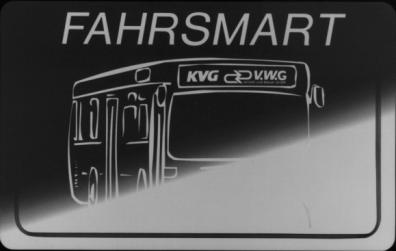
13.2 PUBLIC TRANSPORT |
351 |
Figure 13.9 Fahrsmart II contactless smart card, partially cut away. The transponder coil is clearly visible at the lower right-hand edge of the picture (reproduced by permission of Giesecke & Devrient, Munich)
This means that the card holder has to store money for a specific application in the electronic purse of each closed system and no longer has direct access to this for a different application (e.g. telephone smart card, contactless travel pass, prepaid card for the company restaurant) (Lorenz, 1998b).
This is the result of the card technology used, since the cards that have predominated up until now have only a memory chip and thus do not satisfy the strict security requirements of the credit institutes for open automated financial exchange systems.
Open financial exchange systems based upon a microprocessor chip have already been successfully introduced in the field of contact smart cards. In Germany these systems are the Paycard from Telekom, the VISA-Cash-Karte, and the ‘ec-Karte mit Chip’, the latter having the greatest customer base with approximately 50–55 million cards in use. These cards were designed for payments of small sums and can be used everywhere that suitable readers are available. From the point of view of the user, it would be ideal if the cash card could be used as a ticket for local public transport. Due to the high transaction times of contact smart cards (see Section 13.2.2.1) electronic cash cards have also not yet been able to establish themselves as an electronic travel pass in local public transport applications.
Various solutions have been proposed that aim to combine the user-friendliness of contactless tickets with the security of contact exchange systems, and thus improve the acceptance of such systems by customers (Lorenz, 1998b).
The hybrid card is the combination of a contactless smart card with an additional contact chip on one card. There is, however, no electrical connection between the two chips. This means that it must be possible to transfer sums of money from one chip to the other — for example in special machines. Due to this limitation, the hybrid card too can only be considered as a provisional solution.
The dual interface card (or Combicard, see Section 10.2.1) resulted from the combination of a contact and a contactless interface on a single card chip. This is actually the
